Both Udemy and Udacity are widely recognized as top e-learning platforms, offering life-changing classes for individuals and businesses alike.
But, which is better: Udemy or Udacity?
In this review, I’ll compare and contrast both platforms, considering what they provide, costs, quality of teaching, and platform features.
So, by the end of this article, you'll have have a better idea of the differences between Udemy and Udacity and which one best suits your needs.
This review is detailed. But, if you’re short on time, here are the highlights:
- Udemy is one of the largest Ed Tech companies of its kind, with 80% of Fortune 100 companies trusting Udemy to deliver expert employee upskilling. Such companies include Apple, PayPal, Samsung, and Unilever. It has a greater number of registered users and more courses which can be accessed individually or via a subscription. Its classes are also more varied, from business and technology, to painting and photography
- Udacity’s focus is on upskilling individuals, businesses, and governments – with a focus on in-demand skills in digital technology. As such, it offers far longer courses than you’d find on other sites. Udacity’s courses are more specialized, focused on opening new doors for digi-tech careers. Its trademark courses – Nanodegrees – are also longer and more substantial (around 2-3 months minimum). It is now a subscription only platform.
With both Udemy and Udacity courses, you receive an official (but non-accredited) certificate of completion. You can buy courses individually on Udemy or via a subscription. Udacity is subscription only.
Quick Summary
The side-by-side comparison table below provides a comparison of Udemy and Udacity’s key differences:
| Udemy | Udacity | |
| Average course rating | 4.4 | 4.4 |
| # of users | 64+ million | 16.9+ million |
| # of courses | 210,000+ across 12 categories | 300+ courses across extensive digi-tech categories |
| Teachers | Anyone can create and offer a course | Expert mentors from Fortune 500 and Global 2000 companies |
| Pricing | Individual courses from $12.99 Monthly subscription $26.99 | Subscription either $249 per month, or $2,390 annually |
| Free content | 500+ courses | 200+ courses |
| Accredited certificates | No | No |
| Features | High quality video content and downloadable resources Massive choice of course content from professional to fun Non-accredited certification | Exclusive Nanodegree training programs Industry-expert teaching Career services to complement courses Digi-tech specialization Non-accredited certification |
| Specialization | Anyone can create and offer courses on any topic | In-demand digi-tech topics |
| Pros | Huge range of courses Frequent sales and 500+ free courses Passionate instructors with many high profile contributors Teaches in-demand professional skills and fun, hobbyist courses | Expert mentors with real-world experience Programs designed for businesses, governments, and individuals Extensive course catalog to build your skillset Career services to complement courses Quality content co-created with leading partners |
| Cons | Course quality varies Certificates are non-accredited | Focused on “harder” digi-tech skills like data science Offers fewer “bite-size” courses |
| Best for anyone who: | Wants access to a wide variety of content Is not seeking formal certification Business owners and managers looking to upskill teams | Is seeking a career/promotion in the tech industry |
| More information | Visit Udemy | Visit Udacity |
About Udemy and Udacity
Now let’s take a closer look at both platforms to see what they’re all about.
About Udemy

Launched in 2009, Udemy has quickly risen to one of the top e-learning platforms out there today. With its diversity in terms of courses and teachers, everyone has the opportunity to teach and learn the subjects they’re most passionate about.
At the time of writing, Udemy boasts over 64 million users and offers 210,000+ courses in 12 categories. With its courses ranging from business to music, it really is an all-round learning provider for both professionals and hobbyists.
On Udemy, you can purchase individual courses that are taught by practising instructors. Upon purchasing, you’ll have lifetime access to the course, which means you can review the course and its resources as many times as you want. Some courses are also free!
As well as this, Udemy offers a monthly subscription, called the Personal Plan. This gives you unlimited access to 10,500+ top courses for as long as your subscription is active.
For a more detailed look at Udemy, you can also check out our Udemy review.
About Udacity
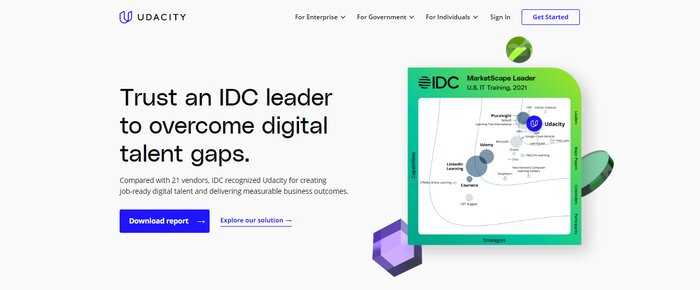
Udacity was founded in 2011 by computer scientists Sebastian Thrun and David Stavens. To date, the platform has over 16 million users and, with partners like Google and Amazon, is considered a breakthrough provider when it comes to digi-tech learning.
As of September 2025, Udacity became a subscription only platform. However, like Udemy, Udacity also boasts over 200 free courses.
As a market leader in talent transformation, Udacity has created content with Amazon, BMW, Microsoft, and GitHub – to name a few. Through these partnerships, Udacity helps to create job-ready talent for an ever-evolving digi-tech career market.
For more detailed information, visit our Udacity review.
Summary: Though their average course rating is the same, Udemy boasts more registered users and a wider range of course categories. That being said, Udacity is arguably a more in-depth platform considering it specializes in a range of digi-tech skills and career resources. Both also offer hundreds of free courses.
Udemy vs Udacity Courses
This side-by-side comparison of Udemy vs Udacity courses sums up what each platform has to offer:
| Udemy | Udacity | |
| # of courses | 210,000 courses in 12 categories | 300+ courses in 9 categories |
| Categories | Development Business Finance & accounting IT & software Office productivity Personal development Design Marketing Lifestyle Photography & video Health & fitness Teaching & academics | Artificial intelligence Autonomous systems Business Cloud computing Cybersecurity Data science Product management Programming & development Career |
| # of free courses | 500+ | 200+ |
Now, let’s take a deeper look.
Udemy Courses
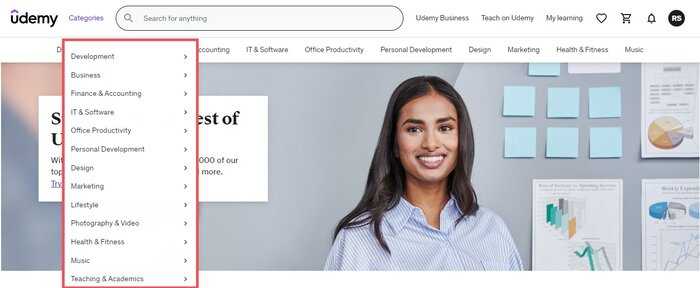
Udemy offers over 210,000 courses across 12 main categories.
Their classes are generally in a pre-recorded format, and can range from one to 20 hours in length. Each course is broken down into bite-sized sections and is led by an instructor who practises the discipline.
These classes are on-demand and consist of your instructor taking you through a mixture of theory and practical skills in your chosen subject. Each course also has additional resources available, such as downloadable texts and articles.
You can browse Udemy’s course catalog by:
- Category
- Recommended topics
- Search bar
To access course categories, hover your cursor over the “Categories” drop-down menu on the homepage. Clicking on any available category will show you all courses available in that subject area.
Once you have started engaging with Udemy, it will begin to recommend suggested courses to your homepage.
Finally, if you’re looking for something more specific, enter keywords into the search bar and click enter.
Best Udemy Courses
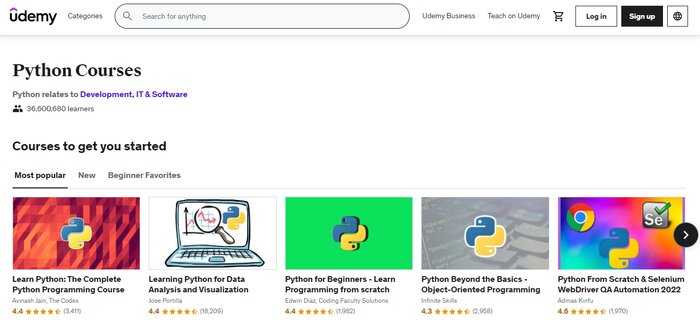
Because Udemy has such a wide range of courses, narrowing these down into the top classes is a difficult task.
And, of course, what’s best for you depends on your own interests and what kind of teaching best suits you.
To give you the broadest possible overview, I’ve grouped together some of Udemy’s best courses from each category below. You can also see our article: Best Courses on Udemy for more.
- Development: 2020 Complete Python Development Programme: From Zero to Hero in Python Start from the basics and grow your professional Python knowledge
- Business: Agile Crash Course: Agile Project Management, Agile Delivery Learn about the key concepts of Agile Project Management
- Finance & Accounting: The Complete Financial Analyst and Training Course Learn to perform financial statement analysis, master Microsoft packages, and build a company’s Balance sheet from scratch
- IT & Software: IT Troubleshooting Skills Training Minimize problem duration, standardize troubleshooting, and practice efficient problem solving
- Office Productivity: Microsoft Excel – Excel from Beginners to Advanced Learn the most common Excel functions, use PivotTables, and unlock the platform’s potential (#1 in our Best Excel Courses list)
- Product Development: Become a Super Learner 2 Master the skills of the world’s fastest readers to learn knowledge both easily and quickly (#2 in our Best Speed Reading Courses list)
- Design: The Ultimate Drawing Course: Beginner to Advanced Draw faces and figures from your head, master realistic light and shadow, and understand art fundamentals
- Marketing: The Complete Digital Marketing Course Grow an online business from scratch, make money as an affiliate marketer, and get hired as a digital marketing expert
- Health & Fitness: Cognitive Behavioral Therapy (CBT) Practitioner Certificate Learn to understand and apply cognitive psychology to everyday life and challenges
- Music: Pianoforall: An Incredible New Way to Learn Piano and Keyboard Learn piano in weeks from basics to advanced, and play by ear (also featured in our Best Online Piano Classes review)
Udacity Courses
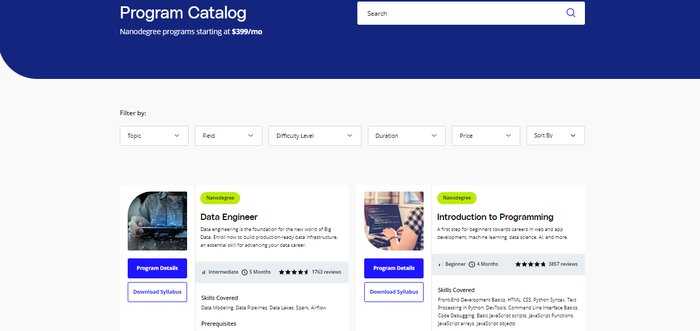
Compared to Udemy, Udacity’s courses are a lot more specialized, focused on upskilling individuals, businesses, and governments in in-demand digi-tech skills.
As such, the course categories are more restricted, but also offer more in-depth subcategories to help you excel in your chosen field.
While Udacity offers some traditional programs and free courses, their trademark offering is their Nanodegree programs. These courses span 3 months on average, and are designed to help you grasp a set of skills through practical learning.
In a typical Udacity Nanodegree program, you can expect the following lesson format:
- Course units with video content and additional resources
- Technical mentor support with human feedback
- Project assignments to encourage hands-on learning
- Career services to complement your course work
- Personalized services including timely project feedback
Like with Udemy, there are a few ways you can search for courses on Udacity:
- Course catalog – browse available subjects on the program catalog
- Recommended pathways – access course recommendations from current courses
- Search bar – enter keywords to find specific fields
Best Udacity Courses
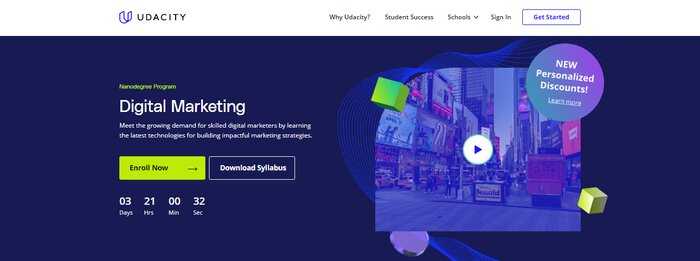
As with Udemy, the best courses for you really depend on your interests. And, more so with Udacity, your career drives are also key factors in determining the best classes for you. So, I’ve rounded up the best Udacity courses based on the subjects available.:
- Artificial Intelligence: Intro to Machine Learning with TensorFlow Learn foundational machine learning techniques, including data manipulation
- Autonomous Systems: Sensor Fusion Engineer Detect obstacles in lidar point clouds, apply thresholds to radar data, and accurately track objects
- Business: Business Analytics Gain foundational data skills applicable to any industry, analyze and present data using Excel and Tableau
- Cloud Computing: Cloud Architect Using Microsoft Azure Learn the skills to translate business requirements into technical specifications
- Cybersecurity: Security Engineer Gain crucial skills in protecting organizations’ computer networks from attacks
- Data Science: Programming for Data Science with R Learn the skills needed to excel in a data science career by grasping the fundamentals of the R programming language
- Product Management: UX Designer Design impactful user experiences and build a profile you can showcase to future employers
- Programming & Development: Android Basics Learn how to develop Android apps with little to no prior experience in programming
- Career: Product Manager Interview Preparation Become versed in understanding mock strategy and technical interviews in order to impress at your next PM interview
Summary: Udemy offers a wider selection of courses, but Udacity offers more course specialities. These are also more career-focused and often include additional resources to help you exceed in interviews or promotions. As such, Udacity’s courses are more serious and directional. In contrast, Udemy can be used in both a professional and casual context.
Udemy vs Udacity: teachers and course quality
When it comes to both online and offline learning, teaching and course quality can make or break a class.
It should go without saying that a good teacher will possess both knowledge and passion for their subject, and be able to distil complex ideas in a way that’s easy to understand. But, beyond that, they also need to establish clear outcomes for the course.
Ultimately, a great teacher will outline what you will learn by the end of the class. Simply put, you need to know what you’ll be able to do or explain by the end of the course that you couldn’t do at the start.
So, with this in mind, how do Udemy and Udacity compare when it comes to teacher quality?
Udemy teachers and quality

On Udemy, anyone has the potential to create and teach a class in any subject they like. But, there are a few guidelines. Firstly, a course must be 30 minutes long minimum. Secondly, they need to have at least five course lessons. And, finally, all topics must be work-suitable.
Aside from this, it’s not essential that Udemy teachers have any formal qualifications in their subject of choice.
However, this doesn’t mean that Udemy teachers are lacking in accreditations or experience. In fact, there are many high-achieving Udemy instructors, including:
- Rob Percival – web developer and teacher with a degree in mathematics from Cambridge University
- Jose Portilla – head of Data Science at Pierian Training, with a current total of 3 million students on Udemy
- Phil Ebiner – top-rated instructor with years of experience in video editing – including feature films
You can become a Udemy instructor by:
- Signing up to Udemy
- Creating learning targets and a class outline
- Filming your course and submitting a test video for feedback
- Submitting your course for Udemy’s approval
If your course meets Udemy’s standards, it will be published.
Once your course is released, Udemy ranks it on a 5* system. So, even though Udemy is open to all, only the best courses will make it to the top. At the time of writing, Udemy has an average course rating of 4.4.
Udacity teachers and quality

Like with Udemy, you don’t have to be a teacher to teach on Udacity. However, some of Udacity’s criteria are a lot stricter.
To become a Udacity instructor, you need to have a demonstrated record of professional experience. You’ll also need to undergo an informal interview and submit a teaching sample for approval.
All of Udacity’s instructors are industry leaders with 5+ years’ professional experience. Esteemed and passionate Udacity instructors include:
- Gabe Ruttner – SQL writer and founder of FeatherDocs.
- Melissa Hui – founder of Context Leap and builder of Udacity’s User Design Capstone Project
- Abhinav Singh – Founding Engineer of Amazon’s Web Services Strategic Security Transformation Team
Summary: Udemy and Udacity are both open to instructor applications. However, Udacity’s criteria for new professors are stricter than Udemy’s, with all instructors having to prove a professional history and field knowledge.
Udemy vs Udacity pricing
| Udemy | Udacity | |
| Per course | $12.99 – $199 | no longer available |
| Subscription | $26.99 per month (billed monthly) for access to 10,500 curated courses | $249 per month or $2,390 per year |
| Free trial | 7 day free trial of subscription | 7 day free trial |
| Refunds | 30 day refund on individual courses Monthly subscription can be cancelled anytime | 7-day refund policy when enrolled on a course |
| Free courses | 500 free courses | 200 free courses |
Udemy cost
Udemy courses range between $12.99 and $199.
That being said, Udemy often has sales and offers major discounts on their courses. For more information, see our article: how often does Udemy have sales?
There are also 500+ courses that can be taken free of charge.
Udemy’s subscription service is known as a Personal Plan. This gives you unlimited access to 10,500 curated courses. It comes with a 7-day free trial, after which you’ll be billed $26.99/month.
You can cancel your subscription at any time, and you can continue to access all content until the next billing date.
Udemy operates a 30-day refund policy, providing your request meets the eligibility criteria. If you’ve taken a significant portion of the course already or have been known to request excessive refunds, your claim could be rejected.
For more detail on Udemy costs, check out our article: Udemy cost.
Udacity cost
As of September 2025, Udacity stopped offering individual enrolment in, and purchase of, its programs.
It is now a subscription platform.
A Udacity subscription membership costs:
- $249 per month
- $2,390 per year (a saving of 20%)
A Udacity subscription membership includes access to the:
- Entirety of Udacity’s catalog of best-in-class content including 80+ Nanodegree and Executive programs and all their courses
- Talent Transformation Suite for tailored learning
- Support Forum to get answers and discuss ideas
Udacity also offers:
- 7-day free trial
- 7-day refund policy
For more detail on Udacity's pricing check our article Udacity Pricing.
Summary: Udacity is more expensive than Udemy. This is because courses are more specialized and are often a lot longer (2-5 months) compared to Udemy’s 30-minute minimum courses. They also come with mentor feedback and additional career resources.
Udemy vs Udacity certificate value
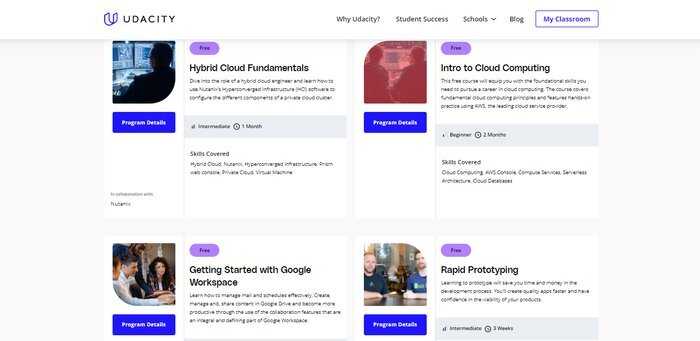
Both Udemy and Udacity offer certificates of completion for their paid courses. However, as neither are accredited institutions, their certificates cannot be used as evidence of formal accreditation.
You can download certificates as PDF or JPEG files, and these can be shared across social media platforms.
Summary: While neither platform offers accredited courses, these certificates are not without merit due to the esteemed professionals teaching the classes, and the field knowledge you’ll undoubtedly acquire.
Udemy vs Udacity platform features
Now, let’s take a closer look at what each platform offers:
Udemy features
- Over 210,000 courses including professional skills and creative options
- Open-to-all teaching with many high profile instructors
- Individual courses that you pay for separately
- A monthly subscription plan giving you access to the 10,500 top courses
- 500+ free courses
- On-demand video lessons and downloadable material
Udacity features
- 300+ courses, including Nanodegree and Executive programs
- Mentor feedback and additional career resources
- 10 scholarship programs sponsored by third-party organizations
- Monthly or annual subscription
- Personalized options for businesses and enterprises
- 200+ free courses
- On-demand video lessons and downloadable material
Udemy vs Udacity customer support
Udemy customer support

Udemy has customer support services available for both students and instructors. These include a customer service webpage with frequently asked questions. You can also browse these by topics, which include account setup, troubleshooting, and refund requests.
If you find that your question is not already covered, you can submit a personal request via Udemy’s contact form. After sending your ticket, you’ll hear back via email within 3-5 business days.
Udacity customer support
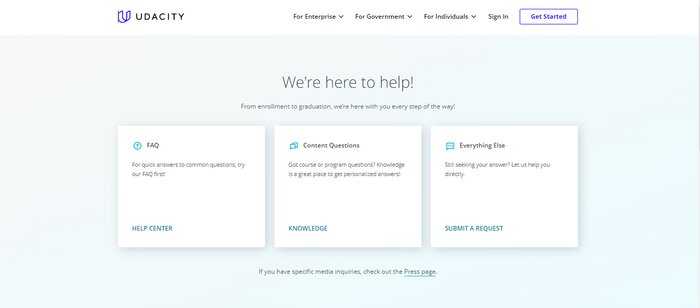
Udacity has a contact page where you can access FAQs and Content Questions. With a search bar function, it’s also easy to find the answers to commonly asked questions.
Further to this, though, there’s a Udacity Support Community where you can start discussions and exchange ideas. You can also submit a request, which Udacity will respond to via email.
Udemy vs Udacity: which is best for Businesses?
Both Udemy and Udacity offer business-specific services. So, the table below highlights the key similarities and differences between the business features on offer:
| Udemy | Udacity | |
| Small teams | Team Plan of up to 20 users ($360 per user per year)6,500+ course and mobile app | Digital Competency Platform focused on ensuring workplace relevance |
| Larger teams | Enterprise Plan of 21+ users (contact sales) As above + custom topics and the ability to host proprietary courses | Udacity’s Talent Transformation Suite (online consultation) Tailored transformation journey through workshops |
| Leadership | Leadership Development Program (contact sales) 100+ Exec courses from top institutions Live events AI analytics and insights | Udacity for Nations (online consultation) As above + GDP consultation |
| More Info | Visit Udemy | Visit Udacity |
Summary: Udemy offers several easy-access business schemes, whereas Udacity works on a case-by-case basis depending on governing body or business type/size.
Udemy and Udacity alternatives
With the growth of e-learning platforms in the last decade, there’s no shortage of options available.
Coursera
Coursera was founded in 2012 and offers 7,000+ courses from top institutions, including Yale and Harvard. Individual courses start at $9.99 but there are also full (accredited) degrees starting at $9,000. So, if an accredited certificate is something you’re looking for, Coursera is your best pick.
GetSmarter
GetSmarter has over a decade’s experience in delivering career-focused learning for professionals looking to progress with qualifications from elite institutions.
They host a wide range of courses, from Healthcare to Disruptive Technologies. And when you sign up for one of Get Smarter’s courses, you will also get access to a Success Adviser and an ,online campus where can ask questions and interact with the teaching team and other students, creating a great community aspect to the learning experience.
With GetSmarter, you pay per course and on completion you will be issued with an accredited certificate from the institution leading the course.
So if the ability to purchase courses individually, gain accredited certification and receive community support is important to you, GetSmarter is worth considering.
MasterClass
Finally, there’s MasterClass. Unlike Udemy and Skillshare, where anyone can host courses, MasterClass is hosted by the best of the best. Namely, they boast celebrity-level tutelage, from Gordon Ramsay to Bill Clinton – to name a couple.
Along with this feature, MasterClass is also known for its high production values and offers cinema-quality video lessons. And, in fact, at only $15 a month for an individual membership, this is pretty great value for money.
MasterClass has also started to offer MasterClass Sessions, which are 30-day courses you follow with a cohort of other students. You can find out more about this here.
If you want to explore these comparisons further, see our article on Udemy alternatives, Udacity vs Coursera, Udemy vs Coursera and Udemy vs LinkedIn Learning.
Udemy vs Udacity: pros, cons, and who they are best for
Having explored both platforms in depth, here’s what I liked about each, what could be improved, and who these platforms are best for:
Udemy
Pros
- Extensive course range
- Fairly priced with frequent sales and discounts
- 500+ free courses
- Passionate instructors with some high profile teachers
- Mix of professional and fun/creative courses
Cons
- Not all courses are of equal quality
- Non-accredited course certificates
Best for those who:
- Enjoy learning and are after a wide variety of work-related/leisurely content
- Are looking to develop new skills in lesser explored areas
- Want to purchase by individual course
- Passionate students who want to increase their knowledge in their own time
- Business owners and managers looking to upskill their teams
Udacity
Pros:
- Expert mentors with real-world experience
- Programs designed for businesses, governments, and individuals
- Extensive but specialized course catalog to build your skills
- Career services to complement courses
- Quality content co-created with leading partners
Cons:
- Less focused on “pleasure learning”
- Specializes in “harder” digi-tech skills like data science
- Most courses are one month minimum
Best for those who:
- Are already in (or interested in getting into) the digi-tech industry, as individuals, businesses, or government bodies
- Want to upskill their teams and maximize the field’s potential
- Are recently graduated and looking to equip themselves with the best and most current digi-tech skills
- Are passionate about a range of data science and engineering subjects and want to expand their knowledge across multiple programs and disciplines
Conclusion: Udemy vs Udacity
In summary, comparing Udemy to Udacity:
- Udemy’s courses are more varied, Udacity’s courses are more field-specific and industry-related
- Teaching quality is more consistent on Udacity – though there are plenty of esteemed teachers on Udemy, too
- Neither Udemy nor Udacity’s courses are accredited
- Udacity is the more expensive and specialized of the two
- Udemy offers best value for money both for businesses and individuals
So, the answer to the question: “Which is better – Udemy or Udacity?” really comes down to what you’re looking for.
If you’re seriously wanting to refine your skills and keep up-to-date with the digi-tech industries, then Udacity is well-worth the investment.
But, if you’re seeking classes in other categories – particularly those more leisurely, Udemy is probably the better of the two for you.
The good news is that both platforms offer:
- Hundreds of free courses for you to sample before committing to a platform
- Free trials and refunds if you decide the platform/class isn’t what you were looking for
Aside from cost and specialty, the main thing that sets Udemy and Udacity apart is the ability to purchase courses individually on Udemy.
Comparing Udemy and Udacity: our methodology
I searched through each platform to gain all relevant information on pricing, subscription details, range, and quality.
Plus, I even sampled several courses from each to get a better understanding of how the platforms worked and what they focused on. For variety, I tried courses in topics I was familiar with, and also some I was new to. This was a good way to figure out if claims of “beginner-friendly” content really held up.
Beyond this, I looked elsewhere on the Internet to garner other opinions from users with good and bad experiences. This was also a good way to find alternative platforms.
Frequently asked questions
Udacity is better for those focused on a career in digi-tech, whereas Udemy is best for those looking for a wider range of course categories.
Udemy is easily the cheaper platform of the two. But, Udacity’s price point also stems from the course lengths and the personalized features they offer.
Udemy has more courses than Udacity, with 200,000+ to Udacity’s 300+

Rebecca graduated from King's College university with a first class honours in English Language, followed by a Masters' Degree in Eighteenth Century Studies.

You made some good points there. I looked on the internet for the subject and found most persons will consent with your site.
Thank you! 😊 I’m glad you found the points valuable and that others agree as well. I truly appreciate your support and hope you continue to find useful content here!
Thank you for another informative web site. Where else could I get that type of info written in such an ideal manner? I’ve a undertaking that I’m simply now working on, and I have been at the look out for such info.
You’re very welcome! 😊 I’m so glad you found the information helpful. Best of luck with your project! If you ever need more insights, feel free to check back—I’d be happy to help.